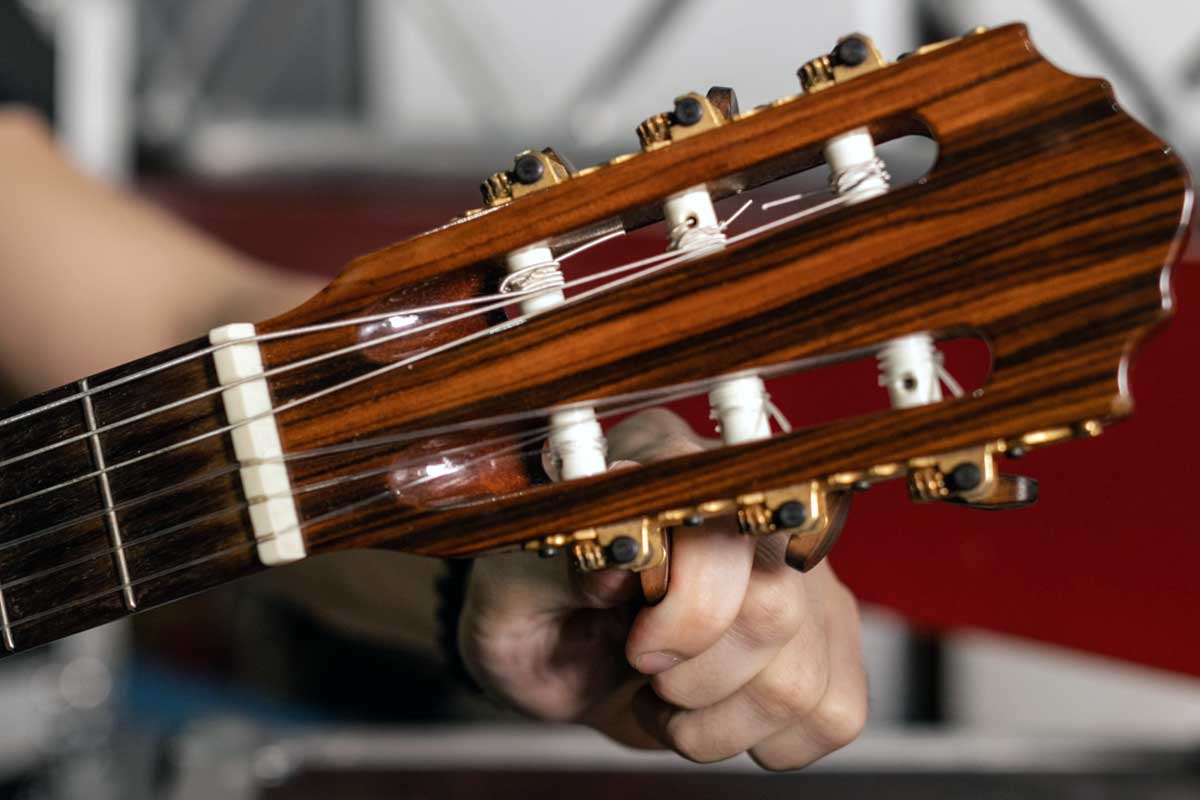Let's look at the pros and cons of using nylon strings versus steel strings to play fingerstyle guitar.
As a fingerstyle guitarist, should you choose between nylon or steel strings, or are both OK?
Although steel string guitar is most commonly used by fingerstyle guitarists, both nylon and steel strings have their own unique characteristics which you can take advantage of in your playing.
In general, nylon strings are found on classical guitars and are suited for a warmer, softer playing style. Steel strings, which are found on acoustic dreadnaught guitars and electric guitars, give a bright, crisp tone. But there's more to it than tone.
Nylon vs. Steel Strings
Before we get into specifics, note that the nylon strings refer to the first, second and third strings which are made of clear or rectified nylon. On a nylon string guitar, the fourth, fifth and sixth strings (the bass strings) are wound with metal wire, often made from silver-plated copper.
With acoustic guitars, the thinner, higher-pitched strings (the first and second strings) are made of plain steel. The lower-pitched strings (the third, fourth, fifth, and sixth strings) are steel cores wound with a metal alloy, typically bronze or phosphor bronze, which gives them their characteristic color and tone.
Nevertheless, we will refer to the guitars as being either nylon or steel string, even though the lower strings of both guitars are wound with metal wire to increase their mass.
Is Fingerstyle Guitar Better With Nylon Strings Instead of Steel?
The choice of which guitar to use ultimately comes down to personal preference. My preference is to use a nylon string guitar, due to the advantages that I list below. However if I am playing a cover song, I will generally opt to use the type of guitar that the original performer employs.
In the case of playing Sungha Jung songs, I generally use a steel string guitar, except in the case of Siesta. Sungha Jung plays this song on a nylon string guitar, and I follow his example.
Pros and Cons of using Nylon Strings for Fingerstyle Guitar
If you choose to play fingerstyle guitar with nylon strings, either on a classical or a crossover guitar, you can take advantage of several things.
Pro: Beautiful Warm Sound
One of the most significant differences between nylon and steel strings is the sound and tone they produce. Nylon strings are known for their warm, mellow, and rounded sound.
They produce a softer and more delicate tone, which is well-suited for classical and fingerstyle guitar playing. On the other hand, this sound is less bright than with steel strings.
Con: Softer Sound For Certain Techniques
Steel strings produce a bright, sharp, and cutting sound. This timbre difference helps bring out harmonics, both natural and harp harmonics.
On the other hand, natural harmonics are a more delicate effect on nylons strings, and some harmonics which sound loud and clear on steel strings are almost inaudible when played on nylon.
Pro: Better For Beginners
Nylon strings are generally easier to play than steel strings, especially for beginners. Nylon strings have lower tension than steel strings, which makes them more comfortable on your fingertips.
In addition, classical guitars, which use nylon string guitars have a wider neck than the acoustic dreadnaught or the electric guitar. This can make it easier to fret certain chords, as you run less of a chance of muting or muffling the adjacent strings with your fingers.
However, crossover guitars or hybrid models, although they have nylon strings, sometimes are constructed with a narrow neck.
Con: Less Sustain
When you pluck a chord on the nylon string guitar, the sound will generally fade away faster than on the steel string guitar. This can be a disadvantage, especially if you are playing a technique which requires a lot of sustain, such as vibrato.
Pro: Easier To Tune
Nylon string guitars come with machine tuning heads which have a much wider shaft. This makes it easier to more precisely tune a nylon string guitar than a steel string, something that's useful if you like to use an alternate tuning.
Because the wider shaft has a greater surface, the tuning peg on a nylon string guitar must be turned over a larger distance as compared to the steel string guitar for the same interval.

However, some specialty flamenco guitars are built with straight pegs (also called friction pegs) in order to save weight. Flamenco guitars are constructed to be as light as possible because the player supports the instrument entirely without a strap.
Friction pegs hold their place by being firmly inserted into a small tapered hole in the headstock. Because they are held in place by friction, they are prone to slipping and becoming out of tune. Furthermore, the shaft being narrower on a tuning peg means that precise tuning is far more difficult than with machine heads.
Con: Longer String Settling Time
In my experience, nylon strings take a much longer time to settle than steel strings. This means that after replacing the strings on my nylon string guitar, they will be substantially out of tune for several days after I change them.
This means that with new nylon strings, I have to spend some time tuning the guitar not only when I start practicing, but also during my practice routine.
On the other hand, steel strings settle almost instantly, and I usually don't notice a huge difference in my guitar being out of tune after putting new steel strings on a guitar.
To speed up the string settling time on my nylon string guitar, I lightly tug upwards on the nylon string away from the guitar neck several times. I find that yanking on the string just a little bit helps the string settle faster.
Pros And Cons of Using Steel Strings For Fingerstyle Guitar
Let's take in the following considerations when using a steel string guitar for fingerstyle guitar.
Pro: Easier To Play Chords With The Thumb
Steel string guitars with their narrow neck, let you use the thumb of the fretting hand to play chords. By reaching the thumb around the neck of the guitar, you can press down on the sixth string and play different chord voicings. This is much harder to do on a nylon string guitar with a wider neck.
By freeing up an extra finger in your fretting hand, you can choose a different finger pattern to play fast passages. For example, you can hold down a note with the thumb and also play legato notes with your other fingers.
Con: Steel Strings Will Wear Down Your Fingernails
Steel strings will chew away at your natural fingernails, especially if you play often or aggressively. Nylon strings will wear down your nails much less than steel strings.
Some guitar players use artificial nails, or simply play steel string guitars with no nails at all to avoid nail breakage. This involves an extra step of applying the fake nails and then further shaping them for guitar playing.

Pro: Easier To Play Special Fingerstyle Techniques
Acoustic guitars with steel strings produce a brighter and louder sound. This is a huge advantage when it comes to playing advanced fingerstyle guitar techniques.
Effects such as tapping and harmonics will sound much clearer and with less effort on the steel string guitar than on the classical guitar. I show you how to play these advanced effects in the complete course for learning fingerstyle guitar, Play Fingerstyle Guitar Now!
In short, the greater responsiveness of steel strings, owing to their higher tension, make this the clear choice for playing fingerstyle guitar songs that include lots of tapping, slapping and other percussive effects.
Con: Increased String Tension
However, because steel strings have significantly higher tension compared to nylon strings, this can require more force with your fretting hand. It can also require you to pluck the strings with more force. This increased tension can lead to hand fatigue and discomfort, particularly if you play for extended periods.
However, the increased string tension means that it is easier to perform certain techniques such as bends and vibrato, in contrast to nylon strings. Because the strings of the steel guitar are under higher tension, bends have a wider pitch variation.
For instance, it's extremely difficult to get a bend of a whole step to sound on a classical guitar. On the other hand, you can readily perform a change in pitch of up to three half steps when performing a bend on the steel string guitar.
When playing fingerstyle on a steel string guitar, choose the lowest possible string tension. My preference is for "extra light tension" strings. You may see this tension referred to by the string thickness; with extra light, the thickness of the first string is .010 inches.
Pro: Longer Durability
When it comes to durability, steel strings have the upper hand. They are made of a more robust and denser material, which makes them resistant to wear and tear.
Older steel strings may break or snap while tuning the guitar or playing aggressively. Change your strings often to avoid this.
Steel strings can last longer and maintain their tone and intonation even after extended use. Nylon strings will more readily lose their tone and intonation over time, especially if you play your guitar often.
Of course, if you want the best possible tone from your guitar, it is best to change your strings as often as possible. If you wait until your strings are completely worn out, you will never get the best possible tone out of your guitar, no matter how good a quality instrument you have.
Con: More Wear On The Guitar
Steel strings when pressed against nickel frets will leave lines on your frets which will cause intonation problems. This wear is unavoidable because steel is harder than nickel.
Eventually, you will have to file your frets to get rid of the divots. The guitar may even require a total re-fret if the divots are deep enough. These impressions on the frets can lead to intonation problems and playability issues down the line.
Pro: Better For Percussive Techniques
The steel string acoustic guitar has a more durable construction, owing to the higher tension of the strings. This makes the body of the guitar more resistant to thumping, if your intention is to play percussive fingerstyle guitar.
On the other hand, classical guitar players rarely use percussion. The exception is flamenco guitar, where guitarists use a percussive technique known as golpe.
In order to to shield the guitar's delicate wooden surface from damage caused by the guitarist's fingernails when employing golpe, flamenco guitarists place a thin plastic layer or protective covering called a golpeador or tap plate.
Con: Less Timbral Variation
This is more subjective, but I find that I can get more variations in timbre or tone on a nylon string guitar than on a steel string. Playing closer to the fretboard or closer to the bridge on a nylon string gives me a huge tonal variation.
I find that the sound from the steel string guitar is more uniform or homogenous across the board.
Of course, the instrument construction can influence the tone quality of the instrument. Both steel stings and nylon string guitars can produce beautiful tone when played in the right way.
You will learn how to produce the correct tone from your instrument in the online course Play Fingerstyle Guitar Now!
Nylon vs Steel Strings for Fingerstyle Guitar: Which Is Better?
When it comes to playing fingerstyle guitar, especially if your intention is to play songs by Sungha Jung, the clear winner is the steel string guitar. The ease in which you can perform advanced techniques on this guitar make the steel guitar the instrument of choice for fingerstyle guitar.
However, if you enjoy playing fingerstyle guitar music on the classical guitar, by all means, choose the nylon string guitar. Fingerstyle music is meant to be enjoyed, and if this gives you the most satisfaction, then the nylon string is the best option.
In order for you to improve your fingerstyle guitar skills, and bring the enjoyment of fingerstyle guitar to everyone, consider a complete course for learning fingerstyle guitar, such as Play Fingerstyle Guitar Now!



